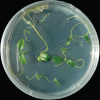Tetraploidization events by chromosome doubling of nucellar cells are frequent in apomictic citrus and are dependent on genotype and environment
- PMID: 21586529
- PMCID: PMC3119611
- DOI: 10.1093/aob/mcr099
Tetraploidization events by chromosome doubling of nucellar cells are frequent in apomictic citrus and are dependent on genotype and environment
Abstract
Background and aims: Polyploidy is a major component of plant evolution. The citrus gene pool is essentially diploid but tetraploid plants are frequently encountered in seedlings of diploid apomictic genotypes. The main objectives of the present study were to establish the origin of these tetraploid plants and to ascertain the importance of genotypic and environmental factors on tetraploid formation.
Methods: Tetraploid seedlings from 30 diploid apomictic genotypes were selected by flow cytometry and genotyped with 24 single sequence repeat (SSR) markers to analyse their genetic origin. Embryo rescue was used to grow all embryos contained in polyembryonic seeds of 'Tardivo di Ciaculli' mandarin, followed by characterization of the plantlets obtained by flow cytometry and SSR markers to accurately establish the rate of tetraploidization events and their potential tissue location. Inter-annual variations in tetraploid seedling rates were analysed for seven genotypes. Variation in tetraploid plantlet rates was analysed between different seedlings of the same genotype ('Carrizo' citrange; Citrus sinensis × Poncirus trifoliata) from seeds collected in different tropical, subtropical and Mediterranean countries.
Key results: Tetraploid plants were obtained for all the studied diploid genotypes, except for four mandarins. All tetraploid plants were identical to their diploid maternal line for SSR markers and were not cytochimeric. Significant genotypic and environmental effects were observed, as well as negative correlation between mean temperature during the flowering period and tetraploidy seedling rates. The higher frequencies (20 %) of tetraploids were observed for citranges cultivated in the Mediterranean area.
Conclusions: Tetraploidization by chromosome doubling of nucellar cells are frequent events in apomictic citrus, and are affected by both genotypic and environmental factors. Colder conditions in marginal climatic areas appear to favour the expression of tetraploidization. Tetraploid genotypes arising from chromosome doubling of apomictic citrus are extensively being used as parents in breeding programmes to develop seedless triploid cultivars and have potential direct use as new rootstocks.
Figures





Similar articles
-
2n megagametophyte formed via SDR contributes to tetraploidization in polyembryonic 'Nadorcott' tangor crossed by citrus allotetraploids.Plant Cell Rep. 2014 Oct;33(10):1641-50. doi: 10.1007/s00299-014-1643-2. Epub 2014 Jun 28. Plant Cell Rep. 2014. PMID: 24972825
-
Tetraploidy enhances the ability to exclude chloride from leaves in carrizo citrange seedlings.J Plant Physiol. 2016 Oct 20;205:1-10. doi: 10.1016/j.jplph.2016.08.002. Epub 2016 Aug 21. J Plant Physiol. 2016. PMID: 27589221
-
Production of tetraploid plants of non apomictic citrus genotypes.Plant Cell Rep. 2009 Dec;28(12):1837-46. doi: 10.1007/s00299-009-0783-2. Epub 2009 Oct 16. Plant Cell Rep. 2009. PMID: 19834711
-
Reassessing Drought Tolerance in Citrus Tetraploid Rootstocks: Myth or Reality?Physiol Plant. 2025 Mar-Apr;177(2):e70199. doi: 10.1111/ppl.70199. Physiol Plant. 2025. PMID: 40171952 Free PMC article. Review.
-
Tetraploidy as a metastable state towards malignant cell transformation within a systemic approach of cancer development.Mutat Res Genet Toxicol Environ Mutagen. 2024 May-Jun;896:503764. doi: 10.1016/j.mrgentox.2024.503764. Epub 2024 May 9. Mutat Res Genet Toxicol Environ Mutagen. 2024. PMID: 38821671 Review.
Cited by
-
Pollen Development and Viability in Diploid and Doubled Diploid Citrus Species.Front Plant Sci. 2022 Apr 25;13:862813. doi: 10.3389/fpls.2022.862813. eCollection 2022. Front Plant Sci. 2022. PMID: 35557738 Free PMC article.
-
Inheritance in doubled-diploid clementine and comparative study with SDR unreduced gametes of diploid clementine.Plant Cell Rep. 2016 Aug;35(8):1573-86. doi: 10.1007/s00299-016-1972-4. Epub 2016 Apr 2. Plant Cell Rep. 2016. PMID: 27038940
-
Assignment of SNP allelic configuration in polyploids using competitive allele-specific PCR: application to citrus triploid progeny.Ann Bot. 2013 Apr;111(4):731-42. doi: 10.1093/aob/mct032. Epub 2013 Feb 18. Ann Bot. 2013. PMID: 23422023 Free PMC article.
-
Extensive citrus triploid hybrid production by 2x×4x sexual hybridizations and parent-effect on the length of the juvenile phase.Plant Cell Rep. 2012 Sep;31(9):1723-35. doi: 10.1007/s00299-012-1286-0. Epub 2012 May 22. Plant Cell Rep. 2012. PMID: 22614256
-
Comparative use of InDel and SSR markers in deciphering the interspecific structure of cultivated citrus genetic diversity: a perspective for genetic association studies.Mol Genet Genomics. 2012 Jan;287(1):77-94. doi: 10.1007/s00438-011-0658-4. Epub 2011 Dec 11. Mol Genet Genomics. 2012. PMID: 22160318
References
-
- Adams KL, Wendel J. Polyploidy and genome evolution in plants. Current Opinion in Plant Biology. 2005;8:135–141. - PubMed
-
- Allario T, Brumos J, Colmenero JM, et al. Autotetraploid Citrus limonia rootstocks are more tolerant to water deficit than parental diploids. International Conference on Polyploidy, Hybridization and Biodiversity. 2009:98. May 17–20, 2009, Saint-Malo, France, program and abstracts. Rennes: Université de Rennes 1.
-
- Albertin W, Brabant P, Catrice O, et al. Autopolyploidy in cabbage (Brassica oleracea L.) does not alter significantly the proteomes of green tissues. Proteomics. 2005;5:2131–2139. - PubMed
-
- Aleza P, Juárez J, Ollitrault P, Navarro L. Production of tetraploid plants of non apomictic citrus genotypes. Plant Cell Reports. 2009;28:1837–1846. - PubMed

